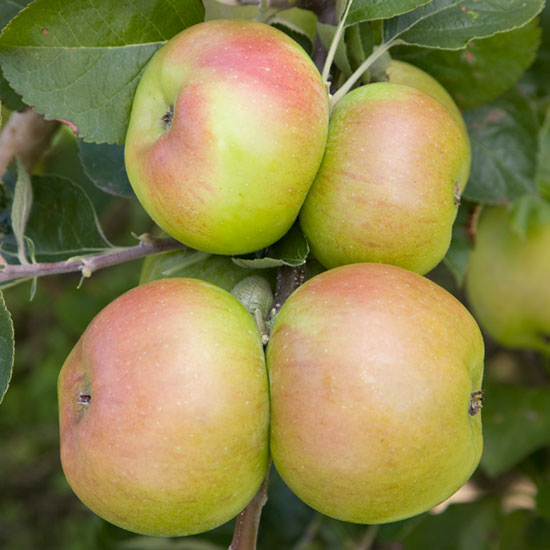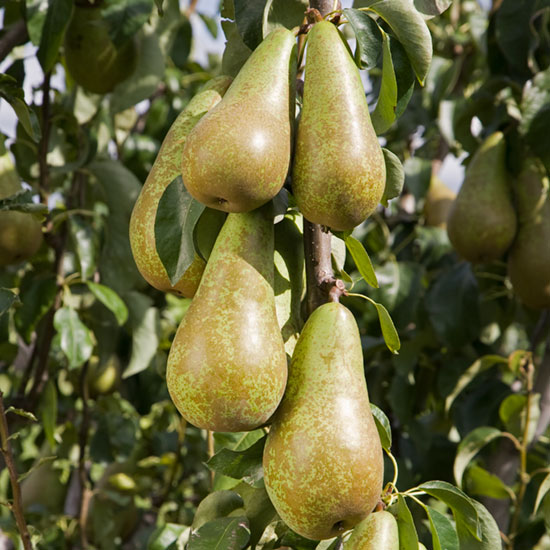Apples and pears are two of the best loved fruits, and they are probably the easiest fruit trees to grow. This has made them a favourite with gardeners along with the fact that only a handful of varieties are available in shops. Gardeners have a much wider range of cultivars to choose from (there are literally hundreds of known varieties) so there is a world of flavours out there to grow and taste. There are also lots of hidden gems with their origins rooted back in our nation’s rich heritage waiting to be discovered.
Apples and Pears – full version PDF
Apples and Pears – printer friendly version PDF
The History of Apples
Research carried out in the 21st century concluded that all sweet apples came originally from a small area of Tian Shan on Kazakhstan’s border with China. They are thought to have then spread into Europe over time by way of the Middle East. There is evidence that apples grew wild in Britain in the Neolithic period but the Romans take the credit for introducing varieties that were sweeter and offered a greater taste. The apple was first documented in England by Kind Alfred in around 885 AD in the English translation of ‘Gregory’s Pastoral Care’.
Apples were a favoured food in Roman times but the orchards were abandoned when the Romans left Britain. This was because the land was so frequently invaded by Jutes, Saxons and Danes so it was hard to sustain any farming of any kind in these fragile times.
New varieties were introduced from France when order was finally restored after the Norman Conquest. The Normans had a strong tradition of apple growing and cider making. They introduced a range of apple varieties to Britain, the first of them being Pearmain and Costard. The Pearmain was valued particularly for cider making and was first recorded in 1204 while the Costard was first recorded in 1296. The name for Costard comes from the word costermonger which was originally a seller of Costard apples. Orchards were common in the grounds of monasteries where cross-pollination was undertaken to create new varieties.
There was a sharp decline in the production of apples in England with the arrival of The Wars of the Roses and the Black Death. Henry VIII instructed his fruiterer to find and introduce new varieties during his reign. The methods used to cultivate apples were relatively crude. It was not until the agricultural revolution of the 18th century that methods changed. One Thomas Andrew Knight carried out a series of controlled experiments in pollination which resulted in many improved varieties. He influenced many nurserymen who continued to develop new varieties which reached a height in the late 19th and early 20th centuries.
Gardening was big business in Victorian times so there was plenty of resources ploughed into producing apples of superior taste. A Richard Cox introduced the famous Cox’s Orange Pippin in 1850 which superseded the Victorian favourite Ribston Pippin. The Bramley’s Seedling, a single purpose culinary apple that is often considered to be the finest cooking apple was first grown in the early 1800s. The original Bramley tree still exists to this day in a garden now known as Bramley Tree House at 75 Church Street, Southwell, Nottinghamshire, England. There is a blue plaque on the wall of the house that tells you that Mary Anne Brailsford grew the tree from a pip between 1809 and 1815.
The production of apples soon took precedence over taste. After the First World War specialist research centres were developed to come up with better production methods that controlled pests and diseases as well as raise new varieties.
Once the UK entered the European Economic Community apples from other countries could be imported in on mass which led to strong competition. In came the high-yielding varieties including the very popular Golden Delicious, Red Delicious and Granny Smith. The competition took many English orchards out of production. The lower yielding varieties were just not profitable enough to compete with the mass produced varieties flooding the market from overseas.
In the early 1990s, Gala and Braeburn, both varieties which had been raised in New Zealand were introduced to the UK. More recently, English growers have planted other varieties including Jazz, Kanzi, Rubens, Cameo and Zari. England has a great climate for apple production because we have adequate rainfall without extreme temperatures. Since 2003 there has been a big revival in the English apple industry due to more intensively planted orchards, more investment from confident growers, innovative equipment and a greater demand from consumers. English apples continue to increase their share of the market which was up to a very impressive 38% in 2011 but sadly, many of our heritage varieties have disappeared from commercial orchards.
The History of Pears
It is believed that pears originated in the Caucasus and were first cultivated more than 4000 years ago. They then spread to Europe and Asia. The ancient Greeks and Romans valued pears for their taste and perceived medicinal benefits. The fruit was consecrated to Aphrodite and Venus, the goddesses of love because it was attributed with aphrodisiacal properties.
It is thought that pears would have been cultivated in Britain during the Roman occupation but there is little documentation. Pears are first mentioned in the Domesday Book which refers to old pear trees as boundary markers.
By the 13th century pears were being used for cooking rather than eaten raw, with many varieties being imported from France. An exception would be the Warden pear that had been bred towards the end of the 14th century.
In 1640 there was at least 64 varieties being cultivated in England. In the 18th century new and improved strains were introduced from what is now Belgium. The purpose of the pear still remained for cooking.
It was in the 19th century that the renowned horticulturist Thomas Andrew Knight started to develop new pear varieties. The Royal Horticultural Society encouraged pear growing and in 1826 there were 622 varieties in their gardens at Chiswick. A breakthrough in the dessert variety took place in 1858 when Doyenne du Comice was introduced into England.
The first English pear to break through into serious production by controlled breeding was Fertility in 1875 (no longer produced commercially). It was not until 1894 that Conference was introduced. Conference and Comice pears overshadowed all other competitors. The recent introduction of Concorde pear has stolen some of the market share away from Conference which continued to grow from strength to strength. These pears now hold a substantial share of the market between them.
Boxing Day Chutney
A simple and very tasty chutney that is ideal as an accompaniment to left-over turkey or cold meats during Christmas.
Ingredients
450g/1lb onions, peeled and chopped
5 tbsp water
900g/2lb cooking apples (peeled, cored and chopped)
700g/1lb 8oz pears (peeled, cored and chopped)
85g/3oz dates (stoned and chopped)
570ml/1 pint cider vinegar
1 tsp salt
1 tsp ground cinnamon
1 tsp cayenne powder
225g/8oz sugar
The method
Place the onions and water in a large heavy-based pan. Bring to the boil and simmer until they soften.
Add in the apples and pears and continue to cook gently for 15-20 minutes. Add to it the dates, salt, spices and half the vinegar. Cook whilst stirring occasionally until the mixture starts to thicken.
Once it has thickened add the sugar and the rest of the vinegar, stirring until the sugar has fully dissolved. Continue to simmer until the chutney becomes really thick and stir occasionally.
When ready spoon the mixture into sterilised jars, seal and leave to mature for a week or longer. Then add your chutney to a classic Boxing Day buffet full of left-over meats, hams, pickles and other festive favourites.


